Updated measurement of time-dependent CP-violating observables in $B^0_s \to J/\psi K^+K^-$ decays
[to restricted-access page]Information
LHCb-PAPER-2019-013
CERN-EP-2019-108
arXiv:1906.08356 [PDF]
(Submitted on 19 Jun 2019)
Eur. Phys. J. C 79 (2019) 706
Inspire 1740746
Tools
Abstract
The decay-time-dependent $CP$ asymmetry in $B^{0}_{s}\to J/\psi K^{+} K^{-}$ decays is measured using proton-proton collision data, corresponding to an integrated luminosity of $1.9 \mathrm{fb^{-1}}$, collected with the LHCb detector at a centre-of-mass energy of $13 \mathrm{TeV}$ in 2015 and 2016. Using a sample of approximately 117 000 signal decays with an invariant $K^{+} K^{-}$ mass in the vicinity of the $\phi(1020)$ resonance, the $CP$-violating phase $\phi_s$ is measured, along with the difference in decay widths of the light and heavy mass eigenstates of the $B^{0}_{s}$-$\bar{B}^{0}_{s}$ system, $\Delta\Gamma_s$. The difference of the average $B^{0}_{s}$ and $B^{0}$ meson decay widths, $\Gamma_s-\Gamma_d$, is determined using in addition a sample of $B^{0} \to J/\psi K^{+} \pi^{-}$ decays. The values obtained are $\phi_s = -0.083\pm0.041\pm0.006 \mathrm{rad}$, $\Delta\Gamma_s = 0.077 \pm 0.008 \pm 0.003 \mathrm{ps^{-1}}$ and $\Gamma_s-\Gamma_d = -0.0041 \pm 0.0024 \pm 0.0015 \mathrm{ps^{-1}}$, where the first uncertainty is statistical and the second systematic. These are the most precise single measurements of these quantities to date and are consistent with expectations based on the Standard Model and with a previous LHCb analysis of this decay using data recorded at centre-of-mass energies 7 and 8 TeV. Finally, the results are combined with recent results from $B^{0}_{s}\to J/\psi \pi^{+} \pi^{-}$ decays obtained using the same dataset as this analysis, and with previous independent LHCb results.
Figures and captions
|
Distribution of the invariant mass of $ B ^0_ s $ candidates, selected from simulated $ B ^0_ s \rightarrow { J \mskip -3mu/\mskip -2mu\psi \mskip 2mu} K ^+ K ^- $ (green filled area), $\Lambda ^0_ b \rightarrow { J \mskip -3mu/\mskip -2mu\psi \mskip 2mu} p K ^- $ (solid red line) and $ B ^0 \rightarrow { J \mskip -3mu/\mskip -2mu\psi \mskip 2mu} K ^+ \pi ^- $ (dotted blue line) decays. The distributions are weighted to correct differences in the kinematics and the resonance content between simulation and data. |
Fig1.pdf [15 KiB] HiDef png [216 KiB] Thumbnail [205 KiB] *.C file |
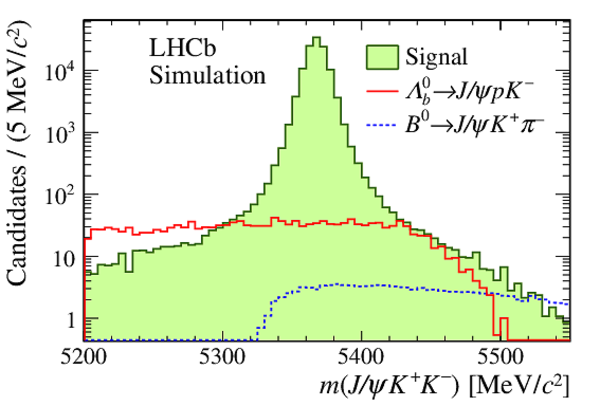
|
|
(a) Distribution of the invariant mass of selected $ B ^0_ s \rightarrow { J \mskip -3mu/\mskip -2mu\psi \mskip 2mu} K ^+ K ^- $ decays. The signal component is shown by the long-dashed red line, the background component by the dashed green line and the total fit function by the solid blue line. The background contribution due to $\Lambda ^0_ b \rightarrow { J \mskip -3mu/\mskip -2mu\psi \mskip 2mu} p K ^- $ decays is statistically subtracted. The contribution from $ B ^0 \rightarrow { J \mskip -3mu/\mskip -2mu\psi \mskip 2mu} K ^+ K ^- $decays is not shown separately due to its small size. (b) Distribution of $ K ^+ K ^- $ invariant mass from selected $ B ^0_ s \rightarrow { J \mskip -3mu/\mskip -2mu\psi \mskip 2mu} K ^+ K ^- $ decays. The background is subtracted using the $sPlot$ method. The dashed blue lines define the boundaries of the six $m(K^{+}K^{-})$ bins that are used in the analysis. |
Fig2a.pdf [45 KiB] HiDef png [223 KiB] Thumbnail [191 KiB] *.C file |
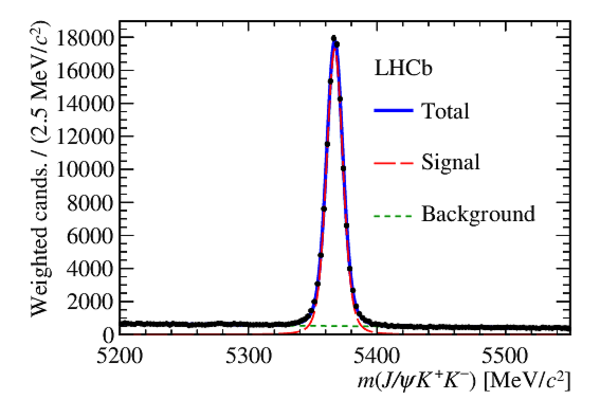
|
|
Fig2b.pdf [24 KiB] HiDef png [167 KiB] Thumbnail [164 KiB] *.C file |
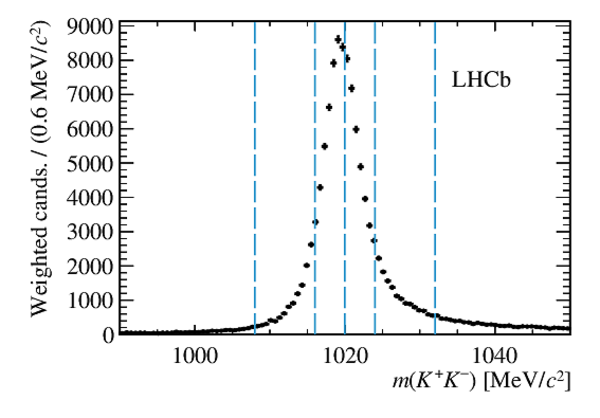
|
|
|
(a) Decay-time distribution of the prompt $ { J \mskip -3mu/\mskip -2mu\psi \mskip 2mu} K ^+ K ^- $ calibration sample with the result of an unbinned maximum-likelihood fit overlaid in blue. The overall triple-Gaussian resolution is represented by the dashed red line, while the two long-lived and the wrong-PV components are shown by the long-dashed-dotted and dashed-multiple-dotted brown and pink lines and the long-dashed purple line, respectively. (b) Variation of the effective single-Gaussian decay-time resolution, $\sigma_{\rm eff}$, as a function of the estimated per-candidate decay-time uncertainty, $\delta_t$, obtained from the prompt $ { J \mskip -3mu/\mskip -2mu\psi \mskip 2mu} K ^+ K ^- $ sample. The red line shows the result of a linear fit. The data points are positioned at the barycentre of each $\delta_t$ bin. The shaded histogram (see right $y$ axis) shows the distribution of $\delta_t$ in the background-subtracted $ B ^0_ s \rightarrow { J \mskip -3mu/\mskip -2mu\psi \mskip 2mu} K ^+ K ^- $ sample. |
Fig3a.pdf [50 KiB] HiDef png [233 KiB] Thumbnail [183 KiB] *.C file |
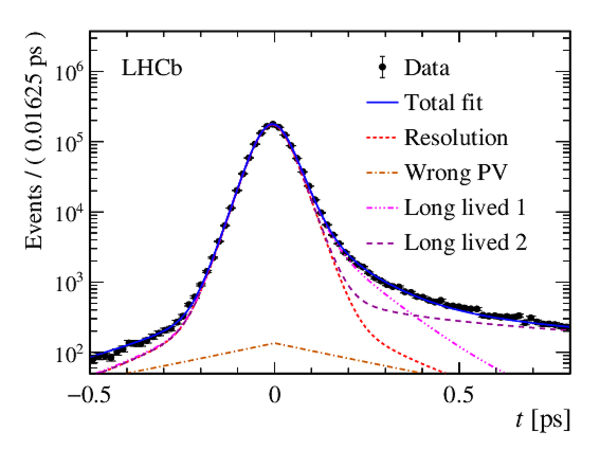
|
|
Fig3b.pdf [14 KiB] HiDef png [344 KiB] Thumbnail [213 KiB] *.C file |
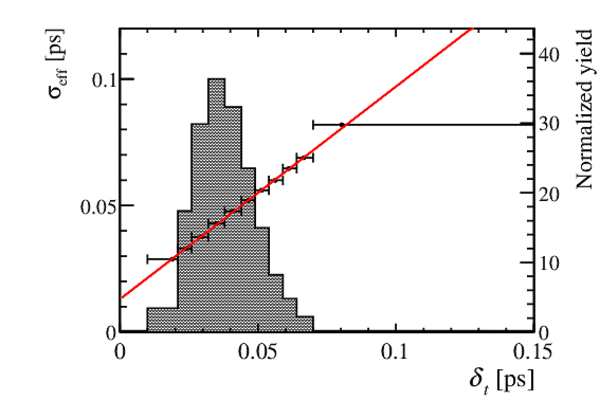
|
|
|
Distribution of the invariant mass of selected (a) $ B ^0 \rightarrow { J \mskip -3mu/\mskip -2mu\psi \mskip 2mu} K^+ \pi^-$ and (b) $B^+ \rightarrow { J \mskip -3mu/\mskip -2mu\psi \mskip 2mu} K^+$ decays used for the calibration and validation of the decay-time efficiency. The signal component is shown by the long-dashed red line, the background component by the dashed green line and the total fit function by the solid blue line. |
Fig4a.pdf [43 KiB] HiDef png [195 KiB] Thumbnail [155 KiB] *.C file |

|
|
Fig4b.pdf [43 KiB] HiDef png [198 KiB] Thumbnail [162 KiB] *.C file |
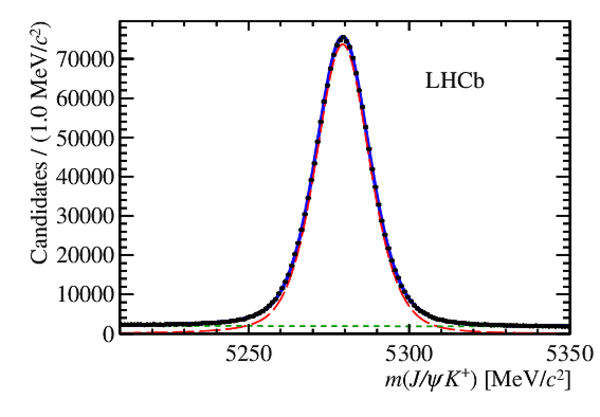
|
|
|
Decay-time efficiency for the (a) 2015 unbiased, (b) 2015 biased, (c) 2016 unbiased and (d) 2016 biased $ B ^0_ s \rightarrow { J \mskip -3mu/\mskip -2mu\psi \mskip 2mu} \phi$ sample. The cubic-spline function described in the text is shown by the blue line. For comparison, the black points show the efficiency when computed using histograms for each of the input component efficiencies. |
Fig5a.pdf [23 KiB] HiDef png [122 KiB] Thumbnail [115 KiB] *.C file |

|
|
Fig5b.pdf [23 KiB] HiDef png [121 KiB] Thumbnail [113 KiB] *.C file |
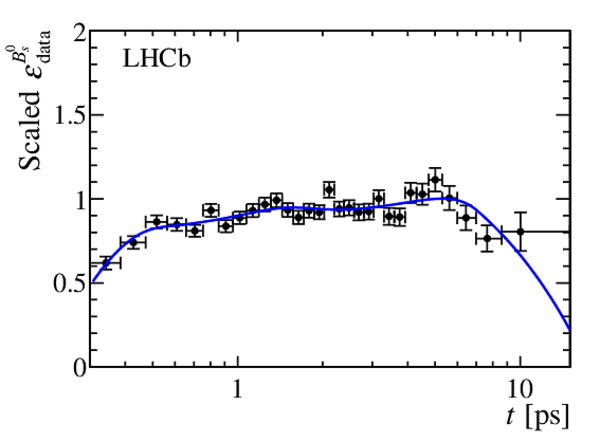
|
|
|
Fig5c.pdf [23 KiB] HiDef png [106 KiB] Thumbnail [94 KiB] *.C file |

|
|
|
Fig5d.pdf [22 KiB] HiDef png [106 KiB] Thumbnail [94 KiB] *.C file |

|
|
|
Normalised angular efficiency as a function of (a) $\cos\theta_K$, (b) $\cos\theta_\mu$ and (c) $\phi_h$, where in all cases the efficiency is integrated over the other two angles. The efficiency is evaluated using simulated $ B ^0_ s \rightarrow { J \mskip -3mu/\mskip -2mu\psi \mskip 2mu} \phi$ decays that have been weighted to match the kinematics and physics of $ B ^0_ s \rightarrow { J \mskip -3mu/\mskip -2mu\psi \mskip 2mu} K ^+ K ^- $ decays in data, as described in the text. The points are obtained by dividing the angular distribution in the simulated sample by the distribution expected without any efficiency effect and the curves represent an even fourth-order polynomial parameterisation of each one-dimensional efficiency. The figure is for illustration only as the angular efficiency is accounted for by normalisation weights in the signal PDF. |
Fig6.pdf [23 KiB] HiDef png [125 KiB] Thumbnail [72 KiB] *.C file |

|
|
Calibration of the OS tagger using $ B ^+ \rightarrow { J \mskip -3mu/\mskip -2mu\psi \mskip 2mu} K ^+ $ decays. The black points show the average measured mistag probability, $\omega$, in bins of predicted mistag, $\eta$, the red line shows the calibration as described in the text and the yellow area the calibration uncertainty within one standard deviation. The shaded histogram shows the distribution, with arbitrary normalisation, of $\eta$ in the background subtracted $ B ^0_ s \rightarrow { J \mskip -3mu/\mskip -2mu\psi \mskip 2mu} \phi$ sample, summing over candidates tagged as $ B ^0_ s $ or $\overline{ B }{} {}^0_ s $. |
Fig7.pdf [26 KiB] HiDef png [216 KiB] Thumbnail [181 KiB] *.C file |
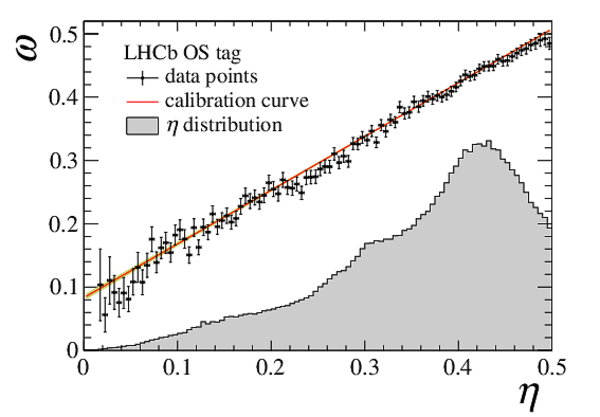
|
|
Distribution of the invariant mass of selected $ B ^0_ s \rightarrow D ^-_ s \pi^+$ candidates (black points). The total fit function is shown as the solid blue line. The signal component is shown by the red long-dashed line, the combinatorial background by the light-blue short-dashed line and other small background components are also shown as specified in the legend. Only the dominant backgrounds are shown. |
Fig8.pdf [41 KiB] HiDef png [236 KiB] Thumbnail [183 KiB] *.C file |

|
|
Variation of the effective single-Gaussian decay-time resolution, $\sigma_{\rm eff}$, as a function of the estimated per-event decay-time uncertainty, $\delta_t$, obtained from the prompt $ D ^-_ s \pi^+$ sample. The red line shows the result of a linear fit to the data and the yellow band its uncertainty within one standard deviation. |
Fig9.pdf [18 KiB] HiDef png [176 KiB] Thumbnail [117 KiB] *.C file |

|
|
(a) Distribution of the decay time for $ B ^0_ s \rightarrow D ^-_ s \pi^+$ candidates tagged as mixed and unmixed with the projection of the fit result, which is described in the text. (b) Calibration of the SSK tagger using $ B ^0_ s \rightarrow D ^-_ s \pi^{+}$ decays. The black points show the average measured mistag probability, $\omega$, in bins of predicted mistag, $\eta$, the red line shows the calibration obtained from the fit described in the text, and the yellow area the calibration uncertainty within one standard deviation. The shaded histogram shows the distribution of $\eta$ in the background subtracted $ B ^0_ s \rightarrow { J \mskip -3mu/\mskip -2mu\psi \mskip 2mu} \phi$ sample. |
Fig10a.pdf [24 KiB] HiDef png [225 KiB] Thumbnail [168 KiB] *.C file |
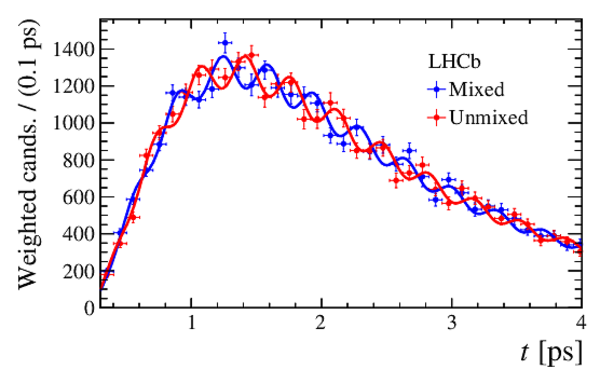
|
|
Fig10b.pdf [17 KiB] HiDef png [208 KiB] Thumbnail [161 KiB] *.C file |
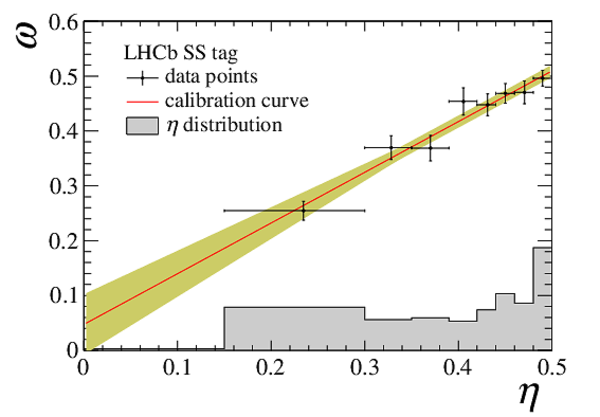
|
|
|
Decay-time and helicity-angle distributions for background subtracted $ B ^0_ s \rightarrow { J \mskip -3mu/\mskip -2mu\psi \mskip 2mu} K ^+ K ^- $ decays (data points) with the one-dimensional projections of the PDF at the maximum-likelihood point. The solid blue line shows the total signal contribution, which contains (long-dashed red) $ C P$ -even, (short-dashed green) $ C P$ -odd and (dotted-dashed purple) S-wave contributions. Data and fit projections for the different samples considered (data-taking year, trigger and tagging categories, $m(K^{+}K^{-})$ bins) are combined. |
Fig11a.pdf [21 KiB] HiDef png [208 KiB] Thumbnail [169 KiB] *.C file |
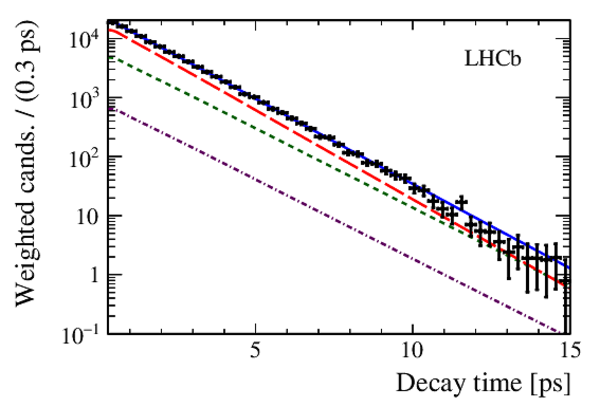
|
|
Fig11b.pdf [19 KiB] HiDef png [213 KiB] Thumbnail [169 KiB] *.C file |
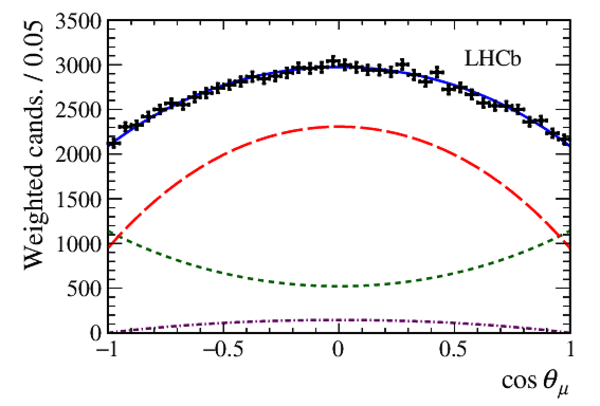
|
|
|
Fig11c.pdf [19 KiB] HiDef png [220 KiB] Thumbnail [180 KiB] *.C file |

|
|
|
Fig11d.pdf [21 KiB] HiDef png [207 KiB] Thumbnail [169 KiB] *.C file |
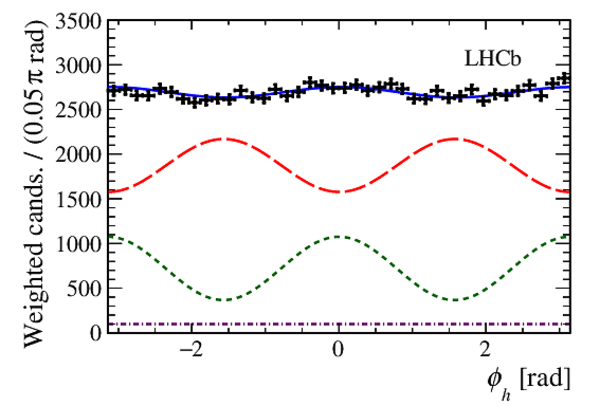
|
|
|
Regions of 68% confidence level in the $\phi_s$-$\Delta\Gamma_s$ plane for the individual LHCb measurements and a combined contour (in blue). The $ B ^0_ s \rightarrow { J \mskip -3mu/\mskip -2mu\psi \mskip 2mu} K ^+ K ^- $ (magenta) and $ B ^0_ s \rightarrow { J \mskip -3mu/\mskip -2mu\psi \mskip 2mu} \pi ^+ \pi ^- $ \cite{LHCb-PAPER-2019-003} (red) contours show the Run 1 and Run 2 combined numbers. The $\phi_s$ \cite{CKMfitter2015} and $\Delta\Gamma_{s}$ \cite{Artuso:2015swg} predictions are indicated by the thin black rectangle. |
Fig12.pdf [102 KiB] HiDef png [398 KiB] Thumbnail [194 KiB] *.C file |
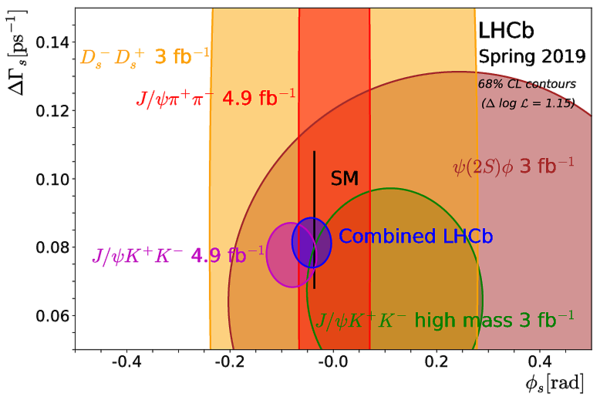
|
|
Animated gif made out of all figures. |
PAPER-2019-013.gif Thumbnail |

|
Tables and captions
|
Calibration parameters for the OS and SSK taggers. Where given, the first uncertainty is statistical and the second is systematic. |
Table_1.pdf [50 KiB] HiDef png [52 KiB] Thumbnail [26 KiB] tex code |

|
|
Overall tagging performance for $ B ^0_ s \rightarrow { J \mskip -3mu/\mskip -2mu\psi \mskip 2mu} K^{+}K^{-}$. The uncertainty on $\epsilon_{\rm tag}D^{2}$ is obtained by varying the tagging calibration parameters within their statistical and systematic uncertainties summed in quadrature. |
Table_2.pdf [52 KiB] HiDef png [79 KiB] Thumbnail [36 KiB] tex code |

|
|
Angular and time-dependent functions used in the fit to the data. Abbreviations used include $c_{K}=\cos\theta_K$, $s_{K}=\sin\theta_K$, $c_{l}=\cos\theta_l$, $s_{l}=\sin\theta_l$, $c_{\phi}=\cos\phi$ and $s_{\phi}=\sin\phi$. |
Table_3.pdf [76 KiB] tex code |

|
|
Summary of the systematic uncertainties. |
Table_4.pdf [74 KiB] HiDef png [135 KiB] Thumbnail [54 KiB] tex code |

|
|
Correlation matrix including the statistical and systematic correlations between the parameters. |
Table_5.pdf [64 KiB] HiDef png [51 KiB] Thumbnail [23 KiB] tex code |

|
|
Correlation matrix for the results in Eq. \eqref{eq:comb1} taking into account correlated systematics between Run 1 and the 2015 and 2016 results. |
Table_6.pdf [63 KiB] HiDef png [53 KiB] Thumbnail [24 KiB] tex code |

|
|
Correlation matrix for the results in Eq. \eqref{eq:comb2} obtained taking into account correlated systematics between the considered analyses. |
Table_7.pdf [47 KiB] HiDef png [44 KiB] Thumbnail [21 KiB] tex code |

|
|
Values of the S-wave parameters in each $m(K^{+}K^{-})$ bin. The first uncertainty is statistical and the second systematic. |
Table_8.pdf [66 KiB] HiDef png [203 KiB] Thumbnail [93 KiB] tex code |

|
Created on 13 April 2024.
